#modality
Text
All About: CANCER ♋︎ - The Zodiac Signs

This post will cover all the basic information needed to understand Cancer, the fourth Zodiac Sign!
Take a look at my other posts to see more information on: Aries, Taurus and Gemini!
Lights... Camera... Action... Because Leo is coming next, keep a look out!
If you feel like this post has helped you feel free to Follow, Reblog or Repost (as long as I'm credited! I'm relatively new to Tumblr so I'm still learning about how all this works)!
~
Cancer ♋︎
Date (Only applies to Sun Signs): June 21 - July 22
Symbol: ♋︎ - The Crab
Associated House: Fourth
Associated Degrees: 4°, 16°, 28°
Associated Energy: Feminine
Planetary Ruler(s): ☾ Moon (Modern and Traditional)
Element: Water
Modality: Cardinal
Keywords: Observant, Protective, Strategic, Expressive, Caring, Nurturing
If you ever need a friend who has always got your back, a Cancer is the right one for the job! Natives of Cancer placements are naturally quite protective, caring and observant people, wanting to nurture the things they care about. When you first meet a Cancer, it may be a somewhat awkward or comforting energy as they tend to be shy when first meeting people, but once they open up and show you who they are that is when you know a Cancer trusts you. On the other end of the spectrum, a Cancer may be friendly to everyone and displays their nature a lot more. This placement, whilst they may enjoy self-improvement and be blunt when giving advice, what they really need is someone who understands them, validates their emotions and cares about the friendship/relationship just as much as them.
Contrary to popular belief of Cancer placements being lazy, they can be extremely hardworking, strategic and put their all into something if they care about it enough. Although this can end up in burn-out if they don't monitor the amount of effort being put in, then the rewards being received.
However, as strong a Cancer may come across - when threatened by something which they view as having lots of control over them they may hide away and become extremely passive, looking for ways to escape. This could be something like a parent, responsibility or an environment where there is a lot of change taking place (examples!). At first they may bottle things up, but if it brews long enough then comes resentment, bitterness, saltiness and it needs to be let out. This can cause a Cancer to act out in anger or upset, maybe become somewhat self-absorbed in the way they view things because it just feels like "no one gets it". Sometimes instead of acting out, they may become passive aggressive instead and continue harbouring resentment. Unless this placement learns healthy communication and has a mode to express themselves, it is possible for these negative emotions to become a cycle.
When a Cancer placement finally feels supported, validated, understood and like they are being nurtured they form an attachment and become a lot more confident, wanting to share themselves with the world. In some cases, this may breed some kind of codependency or over-reliance and this placement may forget to nurture their other responsibilities and interests.
~
Notes/Keywords/Phrases
Zodiac Sign
Each of the Zodiac Signs are a constellation. The Zodiac Sign shows how a Planet/Asteroid/Fixed Point/House is being represented and expressed. Once a Planet/Asteroid/Fixed Point/House falls into a Zodiac Sign, it adopts the energy of it.
For example: if Mercury falls into the constellation Sagittarius, Mercury adopts Sagittarian traits. If the 6th House falls into the constellation Aquarius, the 6th House adopts Aquarian traits.
Associated House
The Houses in Astrology are dependent on the time and location of birth in a Natal Chart and there are 12 different ones. Each of these 12 Houses are then assigned to a Zodiac Sign and 1 or 2 Planetary Rulers. The Houses in Astrology show you what area of life the energy of the Zodiac and Planets/Asteroids/Fixed Points is appointed to and helps provide depth into the chart.
For example: Capricorn's Associated House is the 10th House.
Associated Degrees
When a Planet/Asteroid/Fixed Point/House falls into a Zodiac Sign constellation, it will be appointed a Degree. This Degree shows how far along the Planet/Asteroid/Fixed Point/House is in a Zodiac Sign. Each Degree is also associated with a Zodiac Sign, meaning when this Degree comes up it can nuance the way the Zodiac Sign of a Planet/Asteroid/Fixed Point/House is being represented.
For example: Mars is 6° in the Zodiac Cancer, 6° represents Virgo - therefore the Cancer Mars also takes on Virgo traits. The 2nd House is 23° in the Zodiac Scorpio, 23° represents Aquarius - therefore the 2nd House in Scorpio takes on Aquarian traits.
Planetary Ruler(s)
This phrase refers to the Planet(s) that rule a Zodiac Sign. When a Planet falls into the Zodiac Sign it has rulership over, the energy of both the Planet and the Zodiac Sign is amplified.
For example: Pisces' Planetary Ruler is Neptune.
Modern / Traditional
These words are associated with two kinds of Astrology: Modern Astrology and Traditional Astrology. Traditional Astrology refers to Astrology that was practiced before the 19th century, whilst Modern Astrology refers to Astrology that is practiced now. Some people choose to practice Traditional Astrology, some people choose to practice Modern Astrology, whilst some others might practice both types or combine them together.
Element
Each Zodiac Sign/Planet/House/Degree is associated with an Element and this covers certain traits which are unique to the Zodiac Sign/Planet/House/Degree they correspond to.
These Elements are: Fire, Air, Water and Earth.
Modality
Much like an Element, each Zodiac Sign/Planet/House/Degree is associated with a Modality. The Modality describes what the focus of a placement is and how the energy is expressed.
There are 3 different Modalities: Cardinal, Mutable and Fixed.
#astrology#astronomy#astro observations#astro notes#astro community#tropical astrology#birth chart#aries#modality#Element#natal chart#astrology degrees#astrology houses#zodiac#zodiac signs#astrology community#astroblr#astrologer#self improvement#psychology#spirituality#taurus#gemini#cancer
93 notes
·
View notes
Text
🔥 The Fiery Fervor of the Cardinal Modality 🔥
The Cardinal modality, ablaze with the essence of initiation and creation, is akin to the fiery spark that ignites the celestial hearth. It embodies the vibrant essence of leadership and initiation, urging us to forge ahead fearlessly towards our destined paths. Like the majestic cardinal, this modality possesses an innate vitality and a pioneering spirit, igniting the flames of action and beckoning us to seize the cosmic reins.
🌬️ The Whirling Winds of the Mutable Modality 🌬️
In the infinite cosmic ballet, the Mutable modality emerges as the gentle breeze that continuously shapes and shifts the energetic currents. Just as the mutable signs are versatile and adaptable, this modality bestows upon us the gift of flexibility and a profound ability to navigate the ever-changing tides of existence. Like the whispered secrets of the wind, the Mutable modality whispers transformative wisdom, guiding us towards growth, evolution, and the continuous quest for higher understanding.
🌱 The Steadfast Foundation of the Fixed Modality 🌱
Amidst the celestial symphony, the Fixed modality stands as the firm earth beneath our feet, grounding us in its unwavering grip. It embodies stability, endurance, and the power to manifest our dreams into tangible realities. Like the mighty oak, this modality offers us the tenacity to withstand life's trials and tribulations, nurturing the seeds of growth until they blossom into magnificent creations. With unwavering determination, the Fixed modality encourages us to embrace our inner strength and cultivate the foundations upon which we build our cosmic destinies.
✨🌌 The Harmonious Dance of the Modalities 🌌✨
In the grand cosmic dance, these three modalities intertwine and harmonize, forming a cosmic symphony that orchestrates the ebb and flow of our lives. Each modality, imbued with its unique essence, grants us the opportunity to explore different dimensions of our existence and tap into the boundless potential of the universe.
Remember, dear cosmic voyagers, astrology's modalities are not mere archetypes, but vibrant gateways through which we can access the celestial wisdom that resides within. By embracing the fiery initiation of the Cardinal modality, the transformative whispers of the Mutable modality, and the steadfast foundation of the Fixed modality, we embark upon a journey of self-discovery and alignment with the cosmic currents.
#astro notes#astrology#astrologer#astro observations#astroblr#spiritualawakening#witch community#astrology community#creative inspiration#modality#cardinal signs#fixed signs#mutable signs
39 notes
·
View notes
Text

this is a true sinewave meme
44 notes
·
View notes
Text
Modal verbs
Modal verbs are auxiliary verbs that express notions like possibility, permission, obligation, etc.

Follow @everythingaboutbiotech for informative and useful stuff.
#modalverbs#modality#grammarlessons#learnenglish#esltips#englishgrammar#auxiliaryverbs#modals#englishLanguage#englishteaching#onlineteaching#englishhelp#grammarguide#grammarmatters#grammarcheck#englishisfun#englishteacher#teachingenglish#teachgrammar#englishlearning#englishvocabulary#vocabularywords#wordoftheday#wordpower#englishclass#englishstudent#eltchat#tesol#tesoltips#onlinelearning
14 notes
·
View notes
Text
Fixed Modality in Astrology
What is Modality?
Modality (modes) represents a basic foundation of how energy in motion works in Astrology. Modes represent how energy is begun, carried, and worked with.
Modes are forms of energy grouped in segments known as Quadriplicities. Quadriplicities are groups of classified "energy in motion" consisting of classifications of 4 groups of 3. There are 4 groups of 3 Zodiac signs each, and 4 groups of Astrology house quadrants of 3 houses each.
What is the Purpose of Fixed Modality?
Fixated On a Goal, Desire, or Impulse
Maintaining Energy and Momentum
Allowing Motivation to Drive Forward
Where does Fixed energy fit in the Quadriplicities (groups of modality energy?)
The Fixed portion of each Quadriplicity relates to the energy (sign) or area of life (house) that is in the middle of each specific grouping
Zodiac Signs Associated with Fixed Modality?:
Taurus, Leo, Scorpio, Aquarius
Astrology Houses associated with Fixed Energy:
2nd House, 5th House, 8th House, 11th House
Basic Traits of Fixed Modality Energy:
Motivation
Initiative, Drive, Rationale
Impulse
Desire, Hunger, Resolve
Goal Driven
Ambitious, Proactive, Industrious
Force
Effort, Exertion, Stamina
Doing
Comitting, Maintaining, Executing
Operating
Working, Servicing, Preserving
Enduring
Perpetual, Steady, Persisting
Concentrating
Focusing, Specializing, Devoting
Fixating
Obsessing, Consuming, Possessing
Sturdy
Tough, Stable, Grounded
Firm
Bold, Entrenched, Impermeable
Monotonous
Constant, Steady, Holding
Determined
Intent, Persistent, Reliable
Stubborn
Relentless, Resistent, Stuck
Distant
Indifferent, Forbidden, Uninterested
Defiant
Belligerent, Ill-Disposed, Rebellious
Check out more posts at the Simplify Astrology Masterpost (Click Here)
#Astrology#Fixed#Fixed Signs#Fixed Houses#modality#modes#Taurus#Leo#Scorpio#Aquarius#2nd house#5th house#8th house#11th house#Western Astrology#Vedic Astrology
13 notes
·
View notes
Text
Cisgender Bisexual Pride Flag

Cisgender or cismodal: a gender modality that describes someone experiencing the gender they were assigned at birth.
Bi-: identity that encompasses experiencing attraction between two genders and all genders, with or without gender preferences.
Since I made cisdian and cisbian flags, I felt the need of this one today. This is inclusive of AGAB nonconforming (ANC) people, and multimodal people (those with multiple gender modalities).
See also: cisqueer.
#cismodality#cisgender#modality#cis-modal#pride flags#bisexual#mogai#lgbtqiapn+#cis#cisqueer#cisbi#bicis
15 notes
·
View notes
Text
What does ~わけ mean? (2)
The same post in much higher quality is here -> Link Click
In this #Japanese with anime post, we will take a closer look at a mind-bending structure belonging to the realm of modality and, unfortunately, is usually omitted in translation. It's not that it has to be omitted; it happens that English just sounds better or makes sense without it (in most cases).
Examples in this post are from Jujutsu Kaisen Season 1 and Season 2.
Extra grammar:
というわけ vs. わけ
わけ vs. から/ので
Before we dive in
わけ is truly a mind-bending structure, and knowing just the dictionary definition is not usually enough. The examples provided in textbooks seem to be okay at first glance, but when you start analyzing and comparing わけ to other structures and grammar points, you quickly realize that you haven't fully grasped the concept it actually represents.
Long story short, though. In a lot of cases, わけ can be translated to 'so' or 'then' (: as a necessary consequence; Merriam-Webster).
However, in many cases, English translations don't need to include 'so' or 'then' because things can be simply understood from the context. As readers, we don't need extra lexical help to understand that something is a consequence of something else. The brain fills in that information naturally on its own. Japanese, though, decided that having extra lexical help could be useful.
Note: This article doesn't explain the meaning of structures like わけにはいかない or わけではない. They do have their English equivalents.
I also managed to compile a short list of things that literally enlightened me while struggling to understand what わけ really means and why we need it to sound natural.
In many contexts, わけ indicates that the partners in the conversation share some knowledge.
You really need context to be able to use it. If you were to just enter a room and say a sentence containing わけ, it wouldn't make much sense.
It is used as a reaction/to react to someone else's statement (dialog) or to your surroundings. It shows that you have realized/understood something. Could be paired with だから, それで、なるほど, which are placed at the beginning and わけ at the end, for example:
だから、五条先生強いわけだ。
Ah, so that's why Gojo-sensei is so strong.
Context: We were wondering why Gojo is so strong, and we just found out (someone told us) that Gojo is a six-eye user, and that made us realize why he is so strong.
It is used when the speaker performs a monologue. In this case, we can distinguish two possible situations:
emphasizing inevitable consequences of some actions, i.e. You eat a lot of sugar, so naturally you will gain weight. If you don't add わけ to such a statement, it will be fine as well, but it will sound like a dry fact. However, during a lecture or a conversation about eating habits and their consequences adding わけ will give your sentence the nuance of "And as you know...".
the speaker wants to restate/sum up their own words because their first explanation was unclear. It's like saying "I mean..."; "In other words..."
It is used to restate/paraphrase someone else's words (or your own words). Could be paired with つまり. For example, someone described something to you, but it was complicated. You want to make sure you understand the statement correctly, so you paraphrase it using easier words. You will end that 'easier' sentence with わけ or というわけ.
Used to give the reason for what the conversation partner has said or to state the logical conclusion. Remember that both parties in the conversation need to have the same knowledge. For example:
「田中さんが亡くなったそうだ。」"
I have heard that Tanaka-san has died recently."
「本当?心臓発作だったというわけだな。」
"Really? That must have been a heart attack." (source)
Context: Both of the speakers knew that Tanaka-san had some heart problems, and one of them drew a logical conclusion.
わけではない is used for correcting false impressions
In English, the tone of your voice and intonation will change the meaning of your sentence. In Japanese, though, such changes can be expressed through particle/verb ending choice. A good example can also be ~てしまう.
Consider this sentence:
I didn't invite him to the party because I didn't like him.
It could mean either:
1. I don't want to party with people I don't like. (から)
2. I had other reasons not to invite him, and not liking him wasn't one of them (わけではない)
Even though there are ways to translate わけ into English, it's often omitted in translations.
'Because ' in English is used to provide reasons, but it doesn't really matter if your conversation partner shares knowledge with you. 'Because' can convey completely new information or information already known to everyone for clarity's sake. わけ, on the other hand, speakers must have some prior, common knowledge.
In the following parts of the article, you will find more information related to the above points.
Definition of ~わけ
According to Jisho, it is a noun, and because it is a noun you negate it as a noun, and it conveys the meaning of:
conclusion from reasoning,
judgment or calculation based on something read or heard;
or it just translates to (as a standalone word)
reason; cause; meaning; circumstances; situation.
Stefan Kaiser in his book Japanese: A Comprehensive Grammar defines わけ as
a structural noun [...] used when the speaker realizes that there is an explanation or reason for some occurrence or phenomenon. Or [...] used when the speaker realizes that some fact or occurrence is the result of some other fact or occurrence.
The author mentions that it can be translated to 'so' or 'then'.
Following this definition, let's analyze our first example from Jujutsu Kaisen.
JJK; S01 episode 02 or 03; Yuuji just moved into the school dorms

君の中の宿儺が力を取り戻すために指の在り処を教えてくれる. 君は器である同時に探知機、レーダーでもあるわけだ.
In order to regain its power, the Sukuna you consumed will direct you to the whereabouts of the fingers. You are a vessel as well as a radar.
To better understand this sentence, let's look at more context.
Yuuji has already eaten two of Sukuna's fingers. Since the fingers resonate with each other, he can kind of guess where they are or at least sense their presence (to some degree). Given those facts, we can surmise that Yuuji works like a radar, and that is what Gojo implies by using わけ.
In essence, わけ marks a logical conclusion or result based on some known facts.
Some known facts: Yuuji ate the fingers, they resonate with each other, and he's a vessel...
The conclusion from reasoning/realization: ...you’re a radar.
Notice that the English translation did not include any phrase that would introduce 'conclusion'. It is implied. You could include, for example, 'And that's why...' or something along those lines, but the whole line sounds better without it.
Let's elaborate on it, though. For those of you who don't overthink life or grammar rules, such short dictionary entries might be enough, but I'm a professional overthinker and I just need to know.
~わけ as a modal structure
This section is full of proper linguistic discourse, but don't shy away from it. It might actually help you deepen your understanding of this structure. Japanese grammar books for teachers, and grammar books written in Japanese, list わけ as a modal structure.
For a complete guide to modality, go here ⇒ Link Click
Modality is about a speaker’s or a writer’s attitude towards the world. A speaker or writer can express certainty, possibility, willingness, obligation, necessity and ability by using modal words and expressions. Speakers often have different opinions about the same thing. (Cambridge online dictionary)
Simply put, modal structures help you convey a variety of subjective nuances, for example, instead of saying, I'm wrong, you can say, I might be wrong (might is a modal verb). Let's see what subjective feelings わけ helps us convey:
Certainty or Conviction: わけ is often used when the speaker is confident or certain about the reason they are presenting. It signals that the speaker believes something is true based on their understanding or recognition of a situation.
Explanatory or Justificatory: It is commonly used to explain or justify a statement or action. It adds a sense of "it makes sense that..." or "therefore..." to the statement, showing that the speaker is not just stating a reason but also expressing their conviction or perspective on that reason.
Subjective Interpretation: わけ reflects the speaker's subjective interpretation or understanding of a situation, making it a modal structure because it conveys the speaker's attitude and belief.
An interesting observation has been made in an article titled 「わけだ」文と「からだ」文の意味の違いについて by 牟世鍾 and 宋洙珍 (I'm sorry, I can't decipher their names).
「わけだ」文が表す理由は、対象から納得し、それを理由として位置づけたもの、つまり、話し手が何か認識の過程を経て位置づけたまさにモダリティの形式であり、そのような認識․納得の過程のない直接的な理由を表す「からだ」文とは異なっている。
Which roughly translates to:
The reason expressed by the sentence わけだ is that the speaker is convinced by the object and positions it as the reason, that is, it is the very form of modality that the speaker positions through some recognition process, which is different from the sentence からだ, which expresses direct reasons without such a recognition/convincing process. (translation: mine)
In summary, the passage explains that わけだ places emphasis on the speaker's mental activity by which they become aware of, identify, and understand something (recognition). It involves perceiving, acknowledging, and comprehending information or stimuli in a way that leads to an understanding or recognition of a particular fact, concept, or situation. からだ, on the other hand, is more direct and simply states the reason without highlighting the speaker's internal thought process.
The article also states that
納得の形で提示した理由の文、つまり「わけだ」文は「からだ」文に置き換えられるが、その「からだ」文は「わけだ」文が持っているモダリティ的な意味はなく、単なる理由を表す文になってしまう。
Which translates to:
The statement of reason presented as a form of belief, i.e., the わけだ statement, can be replaced by the からだ statement, but this からだ statement does not have the modality meaning of the わけだ statement and becomes a mere statement of reason.
"A mere statement of reason" refers to a straightforward and explicit connection between the cause and reason; there's no room for confusion or subjective interpretations. Modality, though, is all about subjective interpretations.
For example, in the sentence "I'm late because of traffic," "because of traffic" directly links the cause (traffic) to the effect (being late), making it clear that traffic is the reason for being late. There is a straightforward connection between the two elements.
Okay, let's leave modality and that linguistic talk and move on to something lighter. However, continue reading this article to find out what is the best possible interpretation of Gojo's わけ.
A learner-friendly definition of わけ
After many talks with my Japanese teacher, we managed to pinpoint some reasons for using this structure and what speakers want to convey by using it. Our main goal was to determine why in some cases わけ is a much better option than から.
Let's go back to our Jujutsu Kaisen example:
君の中の宿儺が力を取り戻すために指の在り処を教えてくれる. 君は器である同時に探知機、レーダーでもあるわけだ.
In order to regain its power, the Sukuna you consumed will direct you to the whereabouts of the fingers. You are a vessel as well as a radar. (official translation)
In this case, and as you will see in other examples, わけ most likely conveys:
general/obvious statement. It means that all parties involved in the conversation share the same knowledge and the speaker just confirms everyone's understanding.
the speaker indirectly (through わけ ) asks "You understand, right?" / "You know what that means, right?"
Gojo realizes that Yuuji has enough information to understand his situation, but may or may not know the implications. Yuuji may not know/be sure what all of this means.
Gojo first provided Yuuji with a result and then he stated the reason why achieving this result will be possible. This can also give わけ the meaning of "So no wonder why you work like a radar."
In essence, わけ is used when there is shared knowledge about the situation and the speaker reinforces/confirms everyone's understanding, even when not prompted to do so.
If we replace わけ with から, we will end up with a sentence conveying completely new information to Yuuji. The context of this sentence would have to be different as well.
The original context involves Gojo walking Yuuji around the school and talking to him about the jujutsu world and Yuuji's position in all of this. Yuuji did not ask any questions during their walk, as some things had been explained to him before.
However, if Yuuji was oblivious to his situation and what having eaten the fingers meant for him and the jujutsu world, Gojo would have to provide him with some dry explanations/facts.
The important factor here is 'being oblivious/not knowing enough'.
Let's replace わけ with から then.
[...] 君は器である同時に探知機、レーダーでもあるから。
In order to regain its power the Sukuna you consumed will direct you to the whereabouts of the fingers. Because you are a vessel, a locator as well as a radar.
In English, it still might make sense, but as I mentioned at the very beginning, わけ is often omitted in translation. In translation, we call such cases 'problems with equivalence', which means that one language has something that the other doesn't have or doesn't use it as often as the first one.
If Gojo used から, it would imply that Yuuji didn't know that he was a vessel, that the fingers resonate with each other, and therefore he could be of help to everyone.
The exchange between them could look like this:
Gojo: In order to regain its power the Sukuna you consumed will direct you to the whereabouts of the fingers.
Yuuji:Why? / How come?
Gojo: Because you are a vessel, a locator as well as a radar.
Let's analyze another example from Jujutsu Kaisen.
Nobara just joined the team; S01; Ep03

でかい霊園があってさ、廃ビルとのダブルパンチで呪いが発生したってわけ
There is a big cemetery, and the double whammy with the abandoned building caused the curse.
(again, no English equivalent of わけ)
というわけだ / ってわけだ are just more elaborate ways to express logical conclusions. It's often used with な-adj and nouns. There's a separate section on that, too.
In this case, Gojo gave our main trio two reasons why the curse might have shown up in the abandoned building. The building and the nearby graveyard are those reasons.
If we were to explain the use of わけ here in linguistic terms, we could say that わけ is used to emphasize that the occurrence of the curse is the logical result of the combination of two factors: the large cemetery and the abandoned building. It suggests that there's a logical connection between these two elements that led to the curse. It also adds a sense of logical inevitability.
However, explaining it through our 'learner-friendly definition' we could say that Gojo used it because:
all of them share the same knowledge, namely they all know why curses are born and what the combo of an abandoned building and a graveyard means (general/obvious statement).
It's not like they pulled up to the building oblivious to the world around them, and Gojo had to teach them the basics. Even though they did not ask any questions, he was confirming their understanding of the situation through わけ.
Gojo through わけ also implies something along the lines of "And as you can see..." or "As you probably already realized..."
It could also be the case that they immediately realized that the curse was there, but they didn't know why/weren't sure why. Gojo did not waste time, and instead of waiting for their questions, he supplied the missing information himself.
If we modified the sentence with から, it would still indicate that the curse occurred because of the combination of the large cemetery and the abandoned building. However, it would imply that the main trio didn't know that the connection between the curse being there and the vicinity of the graveyard and abandoned building mattered.
The conversation could go like this:
Gojo: There's a curse in this building.
Them: Why?
Gojo: There is a big cemetery, and the double whammy with the abandoned building caused the curse.
One more example from Season 1, Episode 2.

さすがに特級呪物が行方不明となると―上がうるさくてねえ 観光がてら はせ参じたってわけ
As one would expect when a special-grade cursed object goes missing, the higher-ups won't shut up, so I stopped by while I was out for some sightseeing.
In this case, 'so' perfectly captures the meaning of わけ, as Stefan Kaiser pointed out in his book.
A missing special grade cursed object is a big deal and sorcerers shouldn't take such cases lightly, which Gojo points out to Fushiguro, namely "[...] the higher-ups won't shut up."
Both Gojo and Fushiguro know about it as they belong to this community, which means they share knowledge.
While Gojo is telling Fushiguro why he came, he isn't providing him with new information. In this case, わけ has the nuance of "So you probably realize why I am here."
Because they belong to the same community, Fishuguro understands that ignoring special-grade cursed objects isn't the best of actions, and Gojo just reinforces/confirms his understanding.
One example from Season 2, Episode 8

準備ばっちりってわけだ。
The presence of わけ in this example might not be so clear at first glance. However, the English translations official and unofficial alike somehow manage to capture the meaning of わけ through "I see," which by many learners is instinctively translated to なるほど, though.
As always, we need more context.
Gojo since entering the Shibuya station began to collect information about the situation. He noticed some things that helped him understand/realize what was going on, namely his opponents (Jogo, Hanami, and Choso) prepared for the fight with him.
Through わけ, Gojo shows his realization. At the beginning of this article, I mentioned that わけ can be used as a reaction to someone else's statement. In this case, Gojo is not reacting to someone else's words, but to his surroundings.
In an alternate situation, Jogo or Hanami could also tell him: "Hey! We did this and that!" And Gojo could reply with: "Is that so? It means that you prepared yourself then" (drawing a logical conclusion/natural consequence).
So let's summarize what we have learned about わけ so far.
わけ is a modal structure, which means that the statements marked by it aren't facts but opinions/beliefs/thoughts.
It can be used interchangeably with から, but the nuance changes, and in some cases the meaning.
It marks logical conclusions, which by nature aren't hard facts.
It can also be used to give advice or make general statements based on a logical conclusion.
というわけだ is a more formal and elaborate way to provide a conclusion because there are more reasons stated and this helps us summarize everything.
わけ is used to explain the reason or cause behind something. It helps clarify why a certain situation occurred or why someone did something.
It is often used to provide an explanation or justification.
All parties involved in the conversation share some knowledge / have the same information.
You can't really use it without context, as opposed to から, which can be used without any context.
It conveys the nuance of "As you probably already realized..." or indirectly asks, "You understand, don't you?"
というわけだ / ってわけだ for restating some facts
Apart from というわけだ / ってわけだ being a "more elaborate way to mark logical conclusions", it can also be defined as a structure that paraphrases someone else's or your own words.
わけだ and というわけだ don't really change the meaning of the sentence, but というわけだ is used when the speaker provides more than one reason for something. It is often used with な-adjectives and nouns as opposed to わけだ, which is often seen after verbs. It's not a hard rule, though.
What does paraphrasing mean and why do we do that?
Paraphrasing means that you're trying to use your own words to show how you understand someone's statement. You have analyzed someone's statement and you drew a conclusion.
We do it because we are not sure of our understanding; in a way, we're asking our speaker to confirm our understanding. Modal meaning applies here as well.
In the previous examples, Gojo wasn't restating someone else's words. He was the one to introduce the information.
However, in the example below, Principal Yaga is restating Yuuji's reasons for joining the jujutsu world.
The interview with Yaga; S01; Ep02
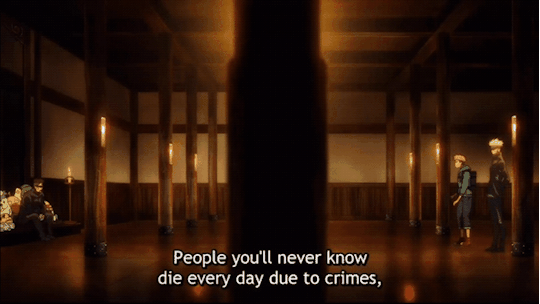
それが呪いの被害となると看過できないというわけか
Yaga just asked Yuuji why he wanted to join the jujutsu high school. Yuuji told him that leaving Sukuna's fingers as they are (unprotected/unsupervised) is dangerous. Yaga drew a conclusion from that, namely:
JJK; Chapter 3; Viz Media

In this case, we actually have something that is considered the equivalent of というわけだ namely, "So you're telling me that [...]". However, remember that not every "so you're telling me that..." needs to be translated to というわけだ.
In the very first chapter, the very first thing Fushiguro says to Gojo is, "You're telling me that someone is keeping a special-grade cursed object in a place like this?!" Fushiguro wasn't restating/paraphrasing Gojo's words.
We can assume that before this panel Gojo told Fushiguro: "There's a special-grade cursed object in the outdoor thermometer box." Fushiguro saw it and just repeated Gojo's words in disbelief, it was sort of a quotation.
Translation problems
In the above examples, わけ could be translated to 'so' or 'then,' but the aim of translation is to make sentences in the target language sound as natural as possible. We could rephrase all of them and include 'so' or 'then' or even any other synonyms, but if the context is clear enough, then including extra lexical help is simply redundant.
Here, we're also dealing with audiovisual translation, where the number of characters in a single line of subtitles matters a lot. Too many words in a single line may hinder the understanding or slow it down and lower the overall experience. And yes, even such short words as 'so' can do it.
Sources
https://briefjapanese.fun/how-to-use-wake/
my Japanese teacher and his native Japanese teacher
Stefan Kaiser, Japanese: A Comprehensive Grammar (p.285)
8 notes
·
View notes
Conversation
Fixed and Mutable Sign couples being a beautiful trainwreck.
Fixed and Cardinal Sign couples having a great, beneficial dynamic but also tension that can burn or drain.
Fixed and Fixed Sign couples having each others backs while also easily stalling out.
Mutable and Mutable Sign couples being soothing as well as uncomfortable like static.
Mutable and Cardinal Sign couples having teamwork that makes the dream work, but also influx catastrophes.
Cardinal and Cardinal Sign couples being a wonderous, unhinged collision.
120 notes
·
View notes
Text
Words that Express Modality
Words to Express Modality
Hello English learners. Welcome to a new lesson. Developing knowledge of good vocabulary is essential in language learning. A comprehensive vocabulary will enable you to express your ideas with more ease and more precisely. You’ve probably learned all about modal verbs. But do you know that there are words that express modality too? In today’s lesson, we will look at ten…

View On WordPress
#expressing modality#how to express modality in English#LearnEnglish#modality#modality iexpressions#skype english lessons#ways to express modality in English
5 notes
·
View notes
Photo
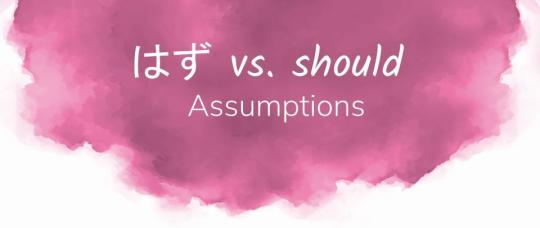
~はず - expressing assumptions in Japanese
For more phrases related to assumptions, go here. べき is here.
はず in English is usually defined as, be supposed to, ought to, should, must, be expected to (I believe). Great, lots of possibilities. However, the more options you have, the warier you need to be of the context.
You can indeed translate はず to should or be supposed to, but you can also translate should to** べき** or even ないと. And these are not as interchangeable in Japanese as they are in English. At least, that's my impression. Correct me if I'm wrong.
For example:
I should go home can be translated to そろそろ帰らないと。
You can say そろそろ帰るはずだ but the meaning changes to They should be on their way home by now.
The first sentence suggests (in an appropriate context) that you have to go home because if you don't go, you might get into trouble.
The second one, though, suggests an assumption. You don't know the truth, and you might get surprised by the final result.
But let's focus on はず only.
Let's take a look at the Japanese definition of that phrase first.
「はずです」は基本的に、「理屈上こうなる」という推論の結果としてのことがらを表わします。
The phrase "はずです" basically expresses something that is the result of an inference that "this is the way it should be in theory."
"In theory" guys! Theory means an idea that you believe is true although you have no proof, or it is a formal idea or set of ideas that is intended to explain something.
For example: 木村さんは英語教師ですから、英語が話せるはずです。
Mr. Kimura is an English teacher, so he should be able to speak English.
In theory, all English teachers should be able to speak English, but the reality might be different. Mr. Kimura's ability to speak English is explained by the fact that he is an English teacher (if that makes any sense to you)
この問題はN2の問題ですから、難しいはずです。
This problem is an N2 problem, so it should be difficult. However, not all N2 problems are difficult.
Note #1: はず often implies the element of surprise. While べき or other phrases, not really.
彼女は今、海外出張なので、今日は来ないはずです.
She is on a business trip abroad now, so she shouldn't be coming today.
To express a negative assumption about the future in English, you can also use will, for example, I doubt she will be coming; It's unlikely she will come; She won't come today.
Note #2: Will for future assumptions can also be used in affirmative sentences. She isn't on a business trip, so she will come. Will sounds like you're more sure of what you're saying. Should - you're less sure.
Note #3: In English, when we talk about assumptions that displease the speaker, we are more likely to use will instead of should.
Let's not go shopping now. The shops will be overcrowded.
In English, things might get a little bit tricky with assumptions about present situations. For instance,
Tom shouldn't know the address - I don't think he knows it unless the context suggests 'no one should tell him.'
トムは住所を知ってはいけない - no one should tell him, he is not allowed to know it
トムはアドレスを知らないはずだ - an assumption
Some examples from the manga Attack on Titan

。。。先にあるはずだけど。。。
Context: They're heading to the place where they're keeping Zeke. She heard an explosion that sounded much like the one caused by the Thunder Spear. They haven't reached the forest yet. So why the heck can she hear it now?
Hange is theorizing in this case - she's developing an idea to explain the situation.
The first theory is that the forest is somewhere further in the distance. The place where they're keeping Zeke should be further ahead. (implicitly - if the Thunder Spear should be heard/used, it should be used there in the forest, not where Hange is).
The second theory is that "Something must have happened there" (in the place where the explosion was heard) or more literally "In the direction of that sound there must/should be something."
You wouldn't really use べき here because that would suggest an obligation, a rule as in "I ordered the forest to be further ahead."
If you tried to translate must to ないと or なければならない or any other "must form,” you would end up expressing a duty of some sort.
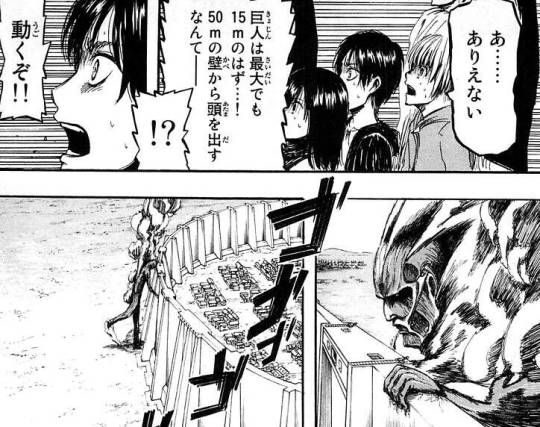
In this example, I believe baby boy Armin said it, they're recalling a theory related to the height of the titans. At most, they should be 15 meters tall. Their knowledge about the titans assumed that the tallest of them are 15 meters. That's the theory they formed, but who would have thought that there is a titan taller than the wall?
I hope this helps! And again, I'm learning just like you guys. If you have any comments, feel free to comment or repost it with your explanations! :)
38 notes
·
View notes
Text
All About: TAURUS ♉︎ - The Zodiac Signs

This post will cover all the basic information needed to understand Taurus, the second Zodiac Sign!
Take a look at my other posts to see more information on: Aries!
Gemini is coming next so keep a look out!
If you feel like this post has helped you feel free to Follow, Reblog or Repost (as long as I'm credited! I'm relatively new to Tumblr so I'm still learning about how all this works)!
~
Taurus ♉︎
Date (Only applies to Sun Signs): April 20 - May 20
Symbol: ♉︎ - The Bull
Associated House: Second
Associated Degrees: 2°, 14°, 26°
Associated Energy: Feminine
Planetary Ruler(s): ♀ Venus (Modern and Traditional)
Element: Earth
Modality: Fixed
Keywords: Stable, Goal-Setters, Stubborn, Calm, Aesthetician, Trustworthy
Taurus, the Zodiac that holds the foundation of everything together - these placements are: stable, grounded, opinionated and are amazing at keeping to a long-term goal. This placement is someone whom also holds themselves quite strongly but has a much calmer demeanor compared to Aries and may be a lot more stubborn too whether they realise it or not. After all, a Taurus placement naturally knows what they want, how to achieve their goals and will never stray from those they are loyal to. As friends, Taurus placements are incredibly loyal and great advice givers (especially in topics regarding relationships, finance and maybe even real estate). That being said, Taurus placements may also be really good in management positions!
Whilst Taurus placements like to give off a calm persona - they don't share their emotions easily and may be pretty avoidant or shy in certain situation. Often this sign has gone through a lot and had some kind of injustice towards them which is deeply unsettling for them and do not deal well with anger. When they feel threatened or they have been disturbed, they may withdraw without much explanation and leave you to figure out what happened... Maybe they become passive and have trouble taking advice.
On the other side of the spectrum, when under stress or unsettled a Taurus placement may "explode" and display a quick-fuse which may come from nowhere but this is usually due some deep-rooted, long-term kind of disturbance they have been trying to suppress. It may be like they "see red".
Once a Taurus feels stable, like they can trust and is receiving constant support (whether that be by money, parents, relationship etc) they will want to enjoy this time as much as possible. However, whilst getting caught up in the aesthetics, beautiful things and enjoyment they may start to lose pieces of themselves and lose sight of the long-term and their own morals, becoming pretty lazy which can result in losses. It's important for a Taurus placement to maintain a healthy balance between enjoying the beautiful things in life but also keeping a sense of realism and moral.
~
Notes/Keywords/Phrases
Zodiac Sign
Each of the Zodiac Signs are a constellation. The Zodiac Sign shows how a Planet/Asteroid/Fixed Point/House is being represented and expressed. Once a Planet/Asteroid/Fixed Point/House falls into a Zodiac Sign, it adopts the energy of it.
For example: if Mercury falls into the constellation Sagittarius, Mercury adopts Sagittarian traits. If the 6th House falls into the constellation Aquarius, the 6th House adopts Aquarian traits.
Associated House
The Houses in Astrology are dependent on the time and location of birth in a Natal Chart and there are 12 different ones. Each of these 12 Houses are then assigned to a Zodiac Sign and 1 or 2 Planetary Rulers. The Houses in Astrology show you what area of life the energy of the Zodiac and Planets/Asteroids/Fixed Points is appointed to and helps provide depth into the chart.
For example: Capricorn's Associated House is the 10th House.
Associated Degrees
When a Planet/Asteroid/Fixed Point/House falls into a Zodiac Sign constellation, it will be appointed a Degree. This Degree shows how far along the Planet/Asteroid/Fixed Point/House is in a Zodiac Sign. Each Degree is also associated with a Zodiac Sign, meaning when this Degree comes up it can nuance the way the Zodiac Sign of a Planet/Asteroid/Fixed Point/House is being represented.
For example: Mars is 6° in the Zodiac Cancer, 6° represents Virgo - therefore the Cancer Mars also takes on Virgo traits. The 2nd House is 23° in the Zodiac Scorpio, 23° represents Aquarius - therefore the 2nd House in Scorpio takes on Aquarian traits.
Planetary Ruler(s)
This phrase refers to the Planet(s) that rule a Zodiac Sign. When a Planet falls into the Zodiac Sign it has rulership over, the energy of both the Planet and the Zodiac Sign is amplified.
For example: Pisces' Planetary Ruler is Neptune.
Modern / Traditional
These words are associated with two kinds of Astrology: Modern Astrology and Traditional Astrology. Traditional Astrology refers to Astrology that was practiced before the 19th century, whilst Modern Astrology refers to Astrology that is practiced now. Some people choose to practice Traditional Astrology, some people choose to practice Modern Astrology, whilst some others might practice both types or combine them together.
Element
Each Zodiac Sign/Planet/House/Degree is associated with an Element and this covers certain traits which are unique to the Zodiac Sign/Planet/House/Degree they correspond to.
These Elements are: Fire, Air, Water and Earth.
Modality
Much like an Element, each Zodiac Sign/Planet/House/Degree is associated with a Modality. The Modality describes what the focus of a placement is and how the energy is expressed.
There are 3 different Modalities: Cardinal, Mutable and Fixed.
#astrology#astronomy#astro observations#astro notes#astro community#tropical astrology#birth chart#aries#modality#Element#natal chart#astrology degrees#astrology houses#zodiac#zodiac signs#astrology community#astroblr#astrologer#self improvement#psychology#spirituality#taurus
43 notes
·
View notes
Text
Modality & the Zodiacal Signs
This writing is issued in 2 points of emphasis. If you are looking for basic information on the Modes stick to the bold text, for a more intermediate explanation of the modes and signs include all.
I am not including the physical characteristics, because in my opinion this gets carried in ways that need a deeper understanding of the moon and ascendant as well as temperament, but I have included very limited details of ailments since we cannot talk about body parts without mentioning their association to health.
As the sun moves North and South of the equator the yearly course is marked by four critical turning points. These are the solstices and equinoxes which initiate the seasons.
Dividing this movement into 12 equal portions of 30 degrees marks the zodiacal signs. These markings can vary based on the system, whether it is tropical, sidereal, or western sidereal—which has caused confusion & great debate. This is for another time though and for the purpose of clarity, I will be using the Tropical Western system as has been used in the tradition of Western astrology since the 4th century BCE.
Basic differences between these systems:
Sideral provides more of an outer or transpersonal perspective of the souls in relationship to the galaxy that both exists and that we may see post-existence through the shining of dead stars.
Tropical provides the of our relationships to the Sun, as it pertains to our experience on earth.
Both are valid and accurate providing a different landscape or served perspective.
The Zodiacal signs in the nativity serve 3 primary functions in Astrology
To truly understand the variations and historical development I recommend that you take the to time read the source material listed at the end.
The bush broad strokes into something like an ancient class-like system. As images with mythic associations give us the shape of behavior and allude to physical characteristics. When framed as configurations we can see familial or interpersonal relationships of the native. And as residences, this articulates resources and power the native holds or has access to. The constellations themselves were likely set up and are used as such to be the dwelling places of the gods/planets.
For this reason, in the study, a firm understanding of the planets should come before and not after the study of the zodiacal wheel.
Moveable Modality
Moveable or Cardinal signs issue the modality of the beginning of seasons. Corresponding to the first degree of Aries-Spring, Cancer-Summer, Libra-Autumn, Capricorn-Winter.
These signs are action-oriented and are the initiators of the zodiac; loving to start new things. Moveable signs are great at taking risks and making changes but can also be impulsive and restless.
beginning of seasons
needing to take action
movement
agitation
unexpected
objective
quick and immediate
When examining these astrological signs, we see behavioral impulsivity, impatience, and difficulty respecting the limits of resources and people we must consider this subjectively. When framing the modes from Aries to Capricorn, this spontaneity or essence of taking action should be placed on a spectrum with the qualities of elements and lords marking how an action is taken.
The objects associated with the moveable modality are dynamic, action-oriented, sharp, and tactility aligning with the moveable modality's association with agitation and taking action. The events associated with this mode are dynamic and change the atmosphere or theme quickly.
All of these signs are tropical, meaning environmental climate needed for creation.
Aries - The Ram
The characteristics of this sign are bestial (animalistic), terrestrial, quadrupedal, semi-vocal, unprolific, mangling, free & single, lustful & lewd. Classified as; masculine, equinoctial, spring, fiery, and diurnal.
Personality; noble, bold & bright, inconsistent, unruly, arrogant
Northern and of the East Wind timing and actions taken are commanding a crooked short ascension.
Rulership is Mars as Domicile, the Sun 19 is exalted. Venus finds themselves in Detriment here and Saturn 19 reaches Fall. In triplicity with the Sun and Jupiter and finding bounds for Mercury 13-20, Venus 1-12, Mars 21-25, Jupiter 1-6, and Saturn 26-30. Decans; Sun, Venus, and Mars.
Head of cosmos and of body and face. When looking at medical astrology can show ailments in the ways of; headaches, poor eyesight & blindness, afflictions to teeth & hearing-possibly deafness, Hansen’s disease, concussions & cerebral hemorrhaging that can lead to stroke, and bouts of anger.
Cancer - The Crab
The characteristics of this sign are bestial, amphibious, mute, broken, fertile, single & servile. Classified as; feminine, solstitial, summer, nocturnal, and watery.
Personality; regard for reputation, popularity, changeable, inconsistent knowledge, wandering, cheerful
Northern with the North Wind finding a long, straight ascension.
Rularship is the Moon as Domicile, Jupiter 15 is exalted. Saturn finds their detriment here and Mars 28 reaches fall. In triplicity with Venus and Mars and finding bounds for Mercury 14-19, Venus 8-13, Mars 1-7, Jupiter 20-25, and Saturn 26-30. Decans; Moon, Mercury, Venus.
Ascendant, breast & ribs of the cosmos and body. Including the chest, spleen, stomach, and posture which can include medical ailments corresponding to the physical location, as well as edema.
Libra - Scales
The characteristics of this sign; are human, vocal, whole, unprolific, violent, single & servile, lustful & lewd. Classified as; masculine, equinoctial, autumnal, diurnal, and airy.
Personality; good and just though malicious, desires the goods of others, irregularity yet oversees balance, weighing, and measuring.
Southern with the West & Southwest Winds timing and actions taken are straight & obeying, long ascension.
Rulership is Venus as Domicile, Saturn 20 is exalted. Mars finds their detriment here and the Sun 19 reaches fall. In triplicity with Saturn and Mercury and finding bounds for Mercury 7-14, Venus 22-28, Mars 29-30, Jupiter 15-21, Saturn 1-6. Decans; Moon, Jupiter, and Saturn.
Subterranean of the cosmos, following in line with the hips, hind parts, groin, bladder, and colon with a medical decrement in these areas as well.
Capricorn - The Goat
The characteristics of this sign; are bestial, amphibious, very wet, unprolific, the cause of evils & troubles, semi-vocal, dual & servile, mysterious/mystifying, and violent. Classified as; feminine, solstitial, wintery, earthy, and nocturnal.
Personality; good and simple, hard-working, stewarding, insomniatic, planning of great things, caring, mischievous, fickle, making mistakes.
Southern with the South Winds, timing and actions taken are crooked & obeying, short ascension.
Rulership is Saturn is Domicile and Mars 28n exalted. The Moon finds their detriment and Jupiter 15 reaches fall. In triplicity with Venus and Moon and finding bounds Mercury 1-7, Venus 15-22, Mars 27-30, Jupiter 8-14, and Saturn 23-26. Decans; Sun, Mars, and Jupiter.
Setting/descendent of the cosmos, knees, and fibrous tissue/tendons that unite the muscle to the bone. Physical ailments can show as; hunched or curved spine, low vision, disability, severe or chronic mental illness, back injuries caused by backbones, and abnormal discharge of humors.
Fixed Modality
The middle of the seasons comes with an air of self-governance, in that action has to be on the terms of that taking action. This is when deep rooting happens, through caution and planning to make sure that action has lasting intents for effect.
When examining these astrological signs we see stability, determination, and persistence. Fixed signs are resistant to change and like to maintain the status quo. When framing the modes for Taurus, Leo, Scorpio, and Aquarius they are loyal and reliable but can also be stubborn and inflexible. The essence of inflexibility should be placed on a spectrum of a sense of security from that which the qualities of elements and lords are marking how the action is taken.
All of these sign are solid, which emphasizes that capability of the dependability and patience required for long term goals.
middle of seasons
needing to maintain
stability
persistent
cautious
defensive
consistent
slow and steady
The objects associated with the fixed modality are conservative, hard to move, solid, steady, reliable, and long-lasting aligning with the fixed modality's association with stability defensiveness, and endurance. The events associated with this mode are stable and last for a long time, a long wait.
Taurus - The Bull
The characteristics of this sign are bestial, terrestrial, quadrupedal, semi-vocal, unprolific, broken, violent, servile & single, lustful & lewd. Classified as; feminine, spring, earthy, and nocturnal.
Personality; good, hardworking & handcrafting, preservation, loving of pleasure and music, industrious, noble, agricultural.
Northern and of the South Wind, timing and actions taken are commanding a crooked short ascension.
Rulership is Venus as Domicile, the Moon 3 is exalted. Mars finds themselves in Detriment here and no planets reach fall. In triplicity with the Moon and Venus and finding bounds for Mercury 9-14, Venus 1-8, Mars 28-30, Jupiter 15-22, Saturn 23-27. Decans; Moon, Mercury, and Saturn.
The house that is sign falls in is Weath bringing off the Cosmos. Ruling over the neck and tendons of the neck, and esophagus. Aliments that are considered involve swollen neck glands, suffocations, eye injuries and diseases, and skin issues that erupt.
Leo - The Lion
The characteristics of this sign are bestial, terrestrial, quadrupedal, semi-vocal, free & single, barren, lewd, and broken. Classified as; masculine, summery, fiery, and diurnal.
Personality; well-tempered, good, insubordinate, notable, hates work, intellectual, tyrannical or kingly, short-tempered, domineering, and arrogant.
Northern and of the East Wind, timing and actions taken are commanding a straight long ascension
Rularship is the Sun as Domicile, with no planets exalted. Saturn finds their detriment and no planets reach fall. In triplicity with the Sun and Jupiter and finding bounds for Mercury 19-24, Venus 7-11, Mars 25-30, Jupiter 1-6, Saturn 12-18. Decans; Mars, Jupiter, and Saturn.
The Heart of the cosmos, the heart itself, and all the this around it like the ribs, tendons, hips, and also the vascular effects to the eyes.
Scorpio - The Scorpion
The characteristics of this sign are bestial, terrestrial, scaly, fertile, broken, mute, single & servile, and cause of foul smells. Classified as; feminine, autumnal, watery, and nocturnal.
Personality; knavish, secret plotters, sorcery, cunning, insatiable, deep thinking, treacherous, rogue-like.
Southern and of the North Wind, timing and actions taken are straight & obeying a long ascension.
Rulership is Mars as domicile, with no planets exalted. Venus finds their detriment and the Moon 3 reaches fall. In triplicity with Venus & Mars and finding bounds for Mercury 12-19, Venus 8-11, Mars 1-7, Jupiter 20-24, Saturn 25-24. Decans; Sun, Venus, and Mars.
Scorpio is the fifth house of the cosmos, ruling over the genitals, bladder, groin, and buttocks. Ailments that can be noted are dimmed vision, tumors, cancers, kidney stones, and the development of fistulas.
Aquarius - The Water-bearer
The characteristics of this sign are human, winged, rational, vocal, unprolific, single & free, violent, wet, and very cold. Classified as; masculine, solid, wintery, airy, and diurnal.
Personality; fearful, single-minded, handicrafts, concealers, deceitful of opinion & truth, misanthropic, and malicious.
Southern and of the West Wind, timing and action taken are obeying & crooked short ascension.
Rulership is Saturn as domicile, with no planets exalted. The Sun finds their detriment and no planets reach fall. In triplicity with Mercury & Saturn and finding bounds for Mercury 1-7, Venus 8-3, Mars 21-25, Jupiter 14-20, Saturn 26-30. Decans; Moon, Mercury, and Venus.
Aquarius is the eighth house of the cosmos, which emphasizes the concern of death. Areas of the body are the shins, legs, and tendons of the lower legs. Ailments that could be considered of the body including but not limited to; arthritis, dopey, some mental illnesses, limb disabilities, incontinence, filariasis, edema, and jaundice.
Common or Mutable Modality
The common modality is ambivalent, variable, and combines the other two modes in a wavering, rapid impulse.
When examining these astrological signs, we tend to see a more adaptable nature with a focus on communication and flexibility. Common signs are often able to see multiple perspectives and are great at adapting to new situations. When framing the modes for Gemini, Virgo, Sagittarius, and Pisces, they are often seen as intelligent and curious, but can also be indecisive and inconsistent. The essence of adaptability should be placed on a spectrum with the qualities of elements and lords marking how the action is taken.
All of these signs are bicoporal meaning, of two bodies.
end of the seasons & change in climate
transitional
combines other modes
wavering
tendencies of inertia
multiplicity in action
flexible
adaptability
diversity in response
The objects associated with the common modality are everyday objects that have multiple uses; versatile, adaptable, and able to change direction easily aligning with the common modality's association with flexibility and adaptability. The events associated have multiple points of impact and are unpredictable and change rapidly.
Gemini - The Twins
The characteristics of this sign are human, winged, vocal & pleasing to the ear, barren, whole, dual & free, and rational. Classified as; masculine, spring, airy, and diurnal.
Personality; fond of discourse, articulate, teachers of voice, working in education & writing, interpreters, commerce, poetic, critics, occult matters, business, and wealth & currency.
Northern and of the (south) West Wind, timing and actions taken are commanding & crooked, short ascension.
Rulership is Mercury in domicile, with no plants exalted. Jupiter finds themselves in detriment, and no planets reach fall. In triplicity with Mercury and Saturn, and finding bounds for Mercury 1-6, Venus 13-17, Mars 18-24, Jupiter 7-12, and Saturn 25-30.
Aquarius is the 12th house of the cosmos and there are no illnesses directly connected to this sign in the references below, but the areas of the body connected to the sign are the hands, shoulders, arms and fingers.
Virgo - The Virgin
Characteristics of this sign are human, winged, barren, vocal, and dual & free. Classified as; feminine, summery, earthy, and nocturnal.
Personality; industrious & practices handicrafts, concerned with the body, modest, mystical, writers, calculating, occult matters, human shape of justice/moral shape of justice, and scrupulous.
Northern and of the South(west) Wind, timing and actions taken are commanding & straight long ascensions.
Rulership is Mercury in domicile, with Mercury exalted. Jupiter finds detriment, and Venus 27 reaches fall. In triplicity with Moon and Venus, and finding bounds for Mercury 1-7, Venus 8-17, Mars 22-28, Jupiter 18-21, and Saturn 29-30.
The cadence of the the cosmos and of the southwest, meaning within the metrics of falling sound and cadent houses. Hidden parts of the body, innards, upper intestines, loins, and belly.
Sagittarius - The Archer
The characteristics of this sign are human & bestial, terrestrial, second half quadrupedal, first half vocal & second half semi-vocal, broken, dual & free, and mysterious. Classifies as; masculine, autumnal, fiery, and diurnal.
Personality; critical, good & just, generous, great-souled, to lose and find things, loves reputation, riddling, authoritative, social fellowships, prevalence, and versatile.
Southern and of the East Wind, timing and actions taken are obeying & straight, long ascensions.
Rulership is Jupiter in domicile, with no planets exalted. Mercury finding detriment, with no planets reaching fall. In triplicity with Sun and Jupiter, and finding bounds for Mercury 18-21, Venus 13-17, Mars 27-30, Jupiter 1-12, and Saturn 22-26.
The cadence of the cosmos, meaning within the metrics of falling sound and cadent houses. The house of forced work or servitude lacking recognition. Ruling over the thighs and groin, with the possibilities of epilepsy, weak sight, baldness, falling from heights, danger from 4 legged animals, injury from barb like objects, animal attacks, extra limbs, and birthmarks.
Pisces - The Fishes
The characteristics of this sign are bestial, fertile, wet, aquatic, broken, mute, and dual & servile. Classifications are; feminine, wintery, watery, and nocturnal.
Personality; of two minds, turns things from bad to good, of/in service, inconsistent, erotic, wandering & dreamy, restless, working on/with water, complicated, sociable, and popular.
Southern and of the North Wind, timing and actions taken are obeying & crooked, short ascensions.
Rulerships is Jupiter in domicile, with Venus 27 exalted. Mercury finding detriment, and Mercury 15 reaching fall. In triplicity with Venus and Mars, and finding bounds for Mercury 17-19, Venus 1-12, Mars 20-28, Jupiter 13-16, and Saturn 29-30.
The good cadence of the cosmos, and the house of God. Ruling over the feet, ankles, sole of the feet, and tendons located here. Finding the possibilities of arthritis, poor posture, gout, diseases of the humors, vitamin c deficiency, STI’s and afflictions from debauchery.
Additional Notes to consider:
When terms like violent or destructive are used this is because the domicile or exalted planet is malefic.
Being whole implies strength, and that these signs are less liable to accidents.
Bestial codification notes on the core instinctual action of the individual.
Free versus servile; the implications of a free sign defines a poised posture, running, standing tall and to be servile or of servitude defines poor posture or slouching, sitting & fatigue, and possible wearyness of the mind.
In single form we consider independence and in dual form this is being with others/companionship.
Vocal is to be a good speaker, semi-vocal of few or select/disorganized verbal communication, and mute or the lacking of voice implies little speech, and stuttering through verbal communication.
Refrences to being unprolific, fertile, or barren is in relationship to the potentials of procreation.
Traits are assumed to be seen through the Asc and Moon sign weighted more heavily and subjectively—as both of the points signify the body.
Source Material:
Valens
Teucer of Babylon
Apotelesmatics
Rhetorius
Manilius
Encyclopedia of Astrology
#astrology#learning astrology#learn astrology#astrologer#traditional astrology#professional astrologer#modality#modes in astrology#cardinal signs#fixed signs#mutable signs#modes
19 notes
·
View notes
Text
Finally time for more conlanging; this time, the moods.
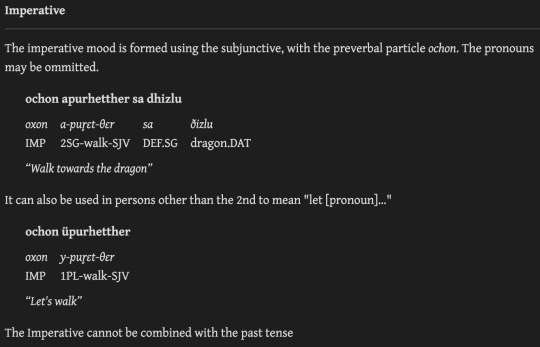


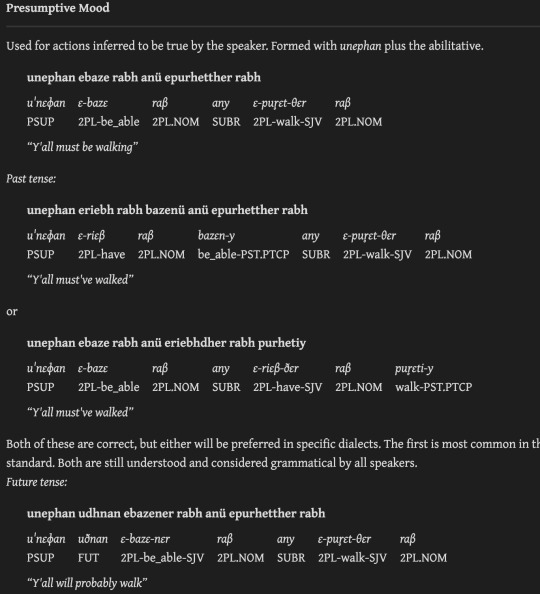
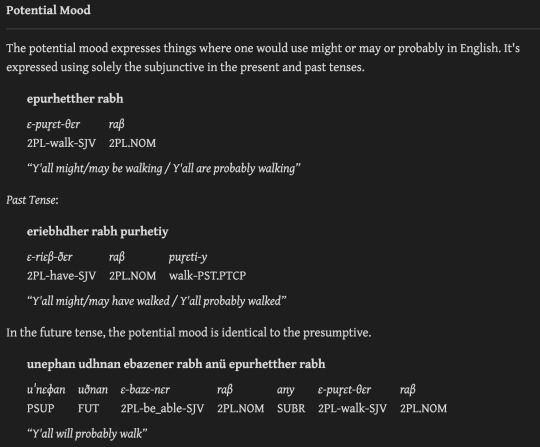
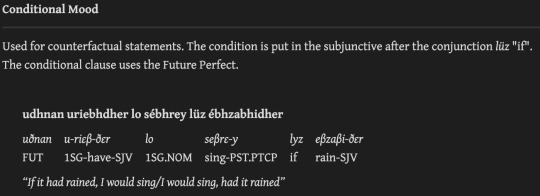
4 notes
·
View notes
Text
Explaining the Modalities
One of the main topics in astrology that most people who only know minimal info about the subject tend to overlook is the modality of the signs. There are three different types of modality; cardinal, fixed, and mutable. The modalities are important in astrology because they are one key in helping us understand the expressions of the signs. The signs that fall under the cardinal category are so…

View On WordPress
#Aquarius#Aries#Astrology#Astrology Blog#Astrology Horoscope#Astrology Post#Cancer#Capricorn#Gemini#Leo#Libra#Modality#Pisces#Sagittarius#Scorpio#Taurus#Virgo
9 notes
·
View notes
Text
Cardinal Modality in Astrology
The following explains the significance of the Cardinal Modality (or mode) energy in Astrology:
What is Modality?
Modality (modes) represents a basic foundation of how energy in motion works in Astrology. Modes represent how energy is begun, carried, and worked with.
Modes are forms of energy grouped in segments known as Quadriplicities. Quadriplicities are groups of classified "energy in motion" consisting of classifications of 4 groups of 3. There are 4 groups of 3 Zodiac signs each, and 4 groups of Astrology house quadrants consisting of 3 houses each.
What is the Purpose of Cardinal Modality?
Commencing Energy in Motion
Building Momentum from Scratch
Getting the Ball Rolling
Where does Cardinal energy fit in the Quadriplicities (groups of modality energy?)
The Cardinal portion of each Quadriplicity relates to the energy (sign) or area of life (house) that starts each specific grouping
Zodiac Signs associated with Cardinal Modality?:
Aries, Cancer, Libra, Capricorn
Astrology Houses associated with Cardinal Energy:
1st House, 4th House, 7th House, 10th House
Basic Traits of Cardinal Modality Energy:
Active
Lively, Dynamic, Enterprising
Engaging
Consuming, Indulging, Monopolizing
Ambitious
Aspiring, Spirited, Bold
Creative
Imaginative, Vision, Original
Building
Generating, Constructing, Producing
Gathering
Amassing, Compiling, Stockpiling
Originator
Trailblazer, Trendsetter, Forerunner
Initative
Drive, Resourceful, Leading
Facilitating
Catalytist, Spark, Boost
Direct
Provoking, Confronting, Stimulating
Brash
Assertive, Aggressive, Pushy
Arrogant
Narcissistic, Pretentious, Boastful
Impulsive
Headstrong, Foolhardy, Thoughtless
Competitive
Forceful, Tenacious, Militant
Check out more posts at the Simplify Astrology Masterpost (Click Here)
#astrology#modality#modes#cardinal#cardinal signs#cardinal houses#aries#cancer#libra#capricorn#1st house#4th house#7th house#10th house#Western Astrology#Vedic Astrology
15 notes
·
View notes
Text

You can have thousands of programs running simultaneously, they feed you perception like your favourite song, food, location, your preferences.
How you see yourself, the world around you, your beliefs, others, even your mindset is linked to it. They affect every aspect of your life including relationships with yourself and others, your finances, your career, your friendships, your experiences and so on. Sometimes we have distortions in our field, corrupted and distorted programming as a result of some event or experience we’ve been through.
When a program becomes corrupted, it creates a distorted perception, which in turn calls in a distorted version of reality.
Working with the field of frequency and energy and being able to ‘see’ into a person's field, I’m able to spot and find these distortions and release them. I co create this aspect with each client as I cannot insert a new program. Think of it like a transplant operation, your own body (subconscious) has to accept the new programming, so it must come from you.
The subconscious mind is smart and it would spot inserted programming which came from outside of you, so therefore you have to insert it.
This is why we do this together. When transplanted, I see the subconscious mind hovering over the new program for a moment, it then takes the new program and within seconds I can see the shift in energetic signature that the client is emitting.
#spiritualpractice#modality#spirituality#subconscious#consciousness#5d#5dconsciousness#12d#spirit#psychic#mystic#wizardoflight#wizard#quantumshift#quantumfield#quantumentanglement#ascension#higherself#lightbody#flow#thirdeye#thirdeyeopen#lightbeings#starseed#lightworker#gridworker#sacredgeometry
3 notes
·
View notes